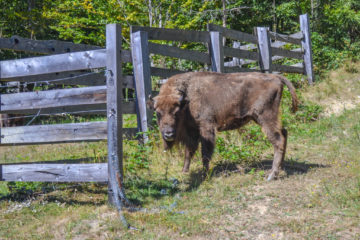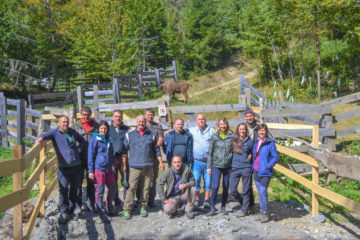The transport of female bison to the release site in the Țarcu Mountains and breeding centre in Hunedoara will enhance the genetic viability of the area’s free-roaming herds and help to minimise the need for future long-distance translocations.

New genes
The reintroduction of European bison in the Southern Carpathians of Romania took another step forward last week with the translocation of four more animals. The quartet of females, three of whom journeyed more than 1000 kilometres from Germany, arrived safely at the release site in the Țarcu Mountains, close to village of Armeniş. Following their acclimatisation they will join the 50-plus bison which are already roaming freely in the area.
Rewilding Europe and WWF Romania have been overseeing the Southern Carpathians bison reintroduction programme since 2014.
“Our goal is to establish a wild bison population that is both demographically and genetically viable,” explains Southern Carpathians rewilding team leader Marina Drugă. “The addition of these four females is very important because it will help to enhance genetic diversity.”
Productive partnership
Three of the four bison were sourced from the Donaumoos Bison Reservation in Germany, with the other female coming from the Bison Breeding Centre in the Romanian city of Hunedoara, which is located 120 kilometres to the northeast of Armeniş. Careful selection on the basis of genetics, age and species management will give the animals the best chance of adapting to and reproducing in their new environment. The females will remain under the close supervision of rangers and a veterinarian during their acclimatisation period.

“The translocation process was both complex and challenging,” says Marina Drugă. “Its success relied on strong collaboration between our professional partners in Germany, the transport company Hunland, and particularly the local community, which has supported us since the very beginning of the reintroduction programme.”
Additional boost
The latest bison translocation also saw Xannika, a female bison from Karlsruhe Zoo in Germany, transported to the breeding centre in Hunedoara. This 6000 square-metre special enclosure was created at Hunedoara Zoo in 2016 by Rewilding Europe and WWF Romania as part of the bison reintroduction programme.
“Xannika will also help to ensure the genetic diversity of future bison generations,” explains Ciprian Hodor, a veterinarian based at the centre.
Releasing bison from the Hunedoara breeding centre into the Southern Carpathians means international translocations of thousands of kilometres, which are potentially very stressful for the animals involved, can be avoided.
“Romarta, a female bison born in the breeding centre two years ago, has just joined the three females from Donaumoos at the Țarcu Mountain release site,” says Hodor. “She exemplifies how the centre will support the reintroduction programme going forwards.”
Record-breaking reintroduction
Once widespread across Europe, wild European bison were driven to extinction in the early twentieth century by hunting and habitat loss. Starting in 2014, the ongoing Rewilding Europe / WWF Romania bison reintroduction programme is the largest ever attempted in the Southern Carpathians, where bison had previously been absent for 200 years.
The first two bison releases took place in 2014 and 2015 in the Țarcu Mountains. In June 2016, a third bison release took place here as part of the European Commission-funded LIFE Bison project, with annual releases now ongoing (the project runs until December 2020). In 2018 another 23 bison were released into the wild, including 14 animals at a second site in the Poiana Ruscă Mountains.
In June 2019 another seven bison were translocated from Germany to the Poiana Ruscă release site, with these animals doing well. This means there are now a total of over 60 bison roaming free in the Țarcu and Poiana Ruscă Mountains.
Community support

Rewilding Europe and WWF Romania cooperate closely with local communities at both bison release sites, with the involvement of entrepreneurs, forest managers, hunting associations and tour operators ensuring the bison reintroduction programme has the best possible outcome.
The goal of Rewilding Europe and WWF Romania is to use wild nature – with a particular focus on the reintroduced bison – to promote the socio-economic development of Southern Carpathian communities. Today such development involves nature-based tourism, community-based and educational initiatives, scientific research and technological innovation. In terms of tourism, a large, free-roaming bison population is a big drawcard, complemented by the rewilding area’s rich local history and culture and stunning landscapes.
